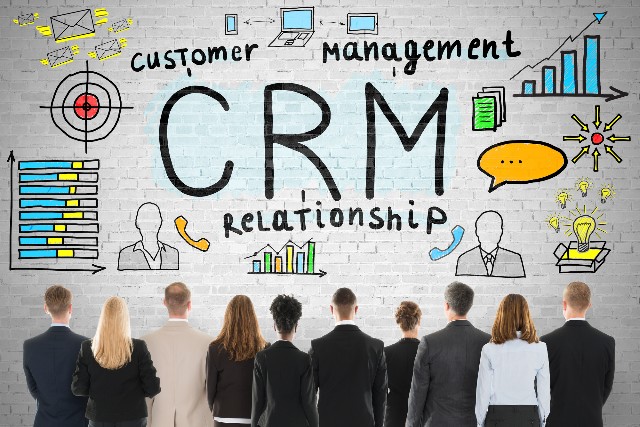Did you know that CRM usage increased from 56% to 74% in 2019, and 49% of companies aim to raise their CRM software spending?
And no wonder. After all, CRMs have proven to be quite useful when it comes to sending out target content to your target audience. This, in turn, helps you boost your conversion rates in no time at all.
But, if you’re completely unfamiliar with the nuances of using a CRM system to the best of its potential, no worries. You’ve come to the right place. Keep on reading for our full breakdown of how you can use your CRM platform to transform your content feedback.
What Is a CRM?
Let’s start with the basics.
A CRM (customer relationship management) is a software system that helps company owners build and maintain strong connections with their customers. Additionally, CRMs aid in organization, efficiency, and time management as well as impressing customers at every stage of the process.
Despite the fact that CRM software has been available since the mid-1990s, it has only just come into its own. Your sales leads and customers may all be gathered in one location using CRM services.
Improve customer service, sales, and income with the aid of a CRM, which records and analyzes all phone and email interactions.
Now, it’s time to take a look at the ways you can use your CRM and its data to your benefit.
Target Content for Your Target Audience: Identification of Customer Personas
In the beginning, you may have used client personas to assist you to identify your ideal customers.
Data from CRM systems may be used to develop your personas and further classify your customer and prospect list into distinct groups. Marketing to each sub-category may then be targeted.
Let’s say, for the sake of argument, that you own and operate an online clothes retailer. It’s possible that you’ve already divided your consumer base into gender groups.
According to their purchasing patterns, geographic area, or stage of life, you might further segment your customers (a person in their 20s is likely to buy very different products to a person in their 60s).
There are many patterns and trends that may be discovered by analyzing your CRM data. As a result, we are able to create more accurate and detailed client personas.
You may then use email marketing, targeted landing pages, and remarketing to give highly tailored experiences to those consumers (more on customization in a minute).
Build Your Content Strategy on CRM Data
You’ll have a wealth of information at your fingertips once you start analyzing your CRM data, segmenting your client base, and developing your customer profiles. Develop content for your target audience and those consumer groups in the following stage.
When you know more about your audience and what they want, you can tailor your content to their needs. When deciding what sorts of material to distribute, keep in mind the problems, wants, and desires of your target audience.
Consider the following options. First, in-depth how-to articles or tutorials that meet particular client requirements in the form of blog entries.
Next, product demonstration films that teach customers how to utilize your items in a variety of ways and FAQs. Also, you can use testimonials from satisfied clients, case studies, and other evidence of your goods’ quality.
And, you can always involve people in your field to generate content that promotes your business.
Tone and Voice
Consider the timbre of your voice as well. Do they prefer a more formal or more casual tone? Is this a lighthearted or somber piece? Make sure all of your material is consistent with your brand’s voice based on what you’ve learned about your consumers.
Keep in mind that not only do you need to think about what material you give to your clients, but where you deliver it. Email marketing is a tried-and-true strategy that appeals to people of all ages and backgrounds.
Social Media and Online Presence
Then you’ll need to choose suitable channels for social media marketing. Instagram is a popular social media content marketing platform for young adults and college students. Senior company leaders are more likely to have a profile on LinkedIn than their junior counterparts are.
There’s no point in putting out the finest content ever if you don’t go where your customers are.
Use Lead Scoring
In the end, not all leads are equal. When tracking potential clients through your sales funnel, many CRM systems allow for lead scoring, in which you can determine how probable it is that they will ultimately buy from you.
Despite the fact that lead scoring isn’t flawless, clients might nevertheless surprise you. However, it is a solid beginning point for deciding where to invest your time, effort, and marketing money. You may utilize this information to target those clients who are most likely to buy from you.
Tailor and Personalize Offers and Communications
Modern marketing relies heavily on a customer’s unique characteristics. Customers no longer want to be treated as simply another number in a lengthy list when interacting with your business.
As a result, people want to feel like you’re speaking directly to them. As a result, you must go above and above to make your consumers feel valued. Even if it’s still vital to include customers’ names in your email marketing subject lines and greeting lines, it’s no longer sufficient.
Your CRM data may be used to allow personalization. Having a better understanding of your consumers allows you to be more tailored in your approach.
After all, tailored marketing methods lead to an average 20% boost in sales.
Highly Personalized eCommerce Marketing Methods
Create an automated homepage and site navigation depending on the interests of your audience. Using the clothes shop as an example, if a customer has previously visited the men’s area, you could automatically route them there. Cookie retargeting allows you to do this.
Personalize product suggestions based on browsing history, demographics, and previous purchases. With that in mind, you may recommend matching shoes and a purse for a new dress that someone just purchased.
Make use of geolocation targeting. It makes sense to automatically send customers to the correct homepage based on their location if your shop has a worldwide presence.
Use your customer’s habits, hobbies, and purchasing history to tailor specials and discounts. Your sales will rocket with a customized bonus funnel.
As soon as your consumer adds an item into their basket, but doesn’t proceed to checkout, send them tailored cart abandonment emails. Send a birthday present or special offer to your consumers.
When it comes to customizing your experience, the possibilities are almost unlimited. Remember that eCommerce marketing is not a place for generic messaging. For repeat clients, you need to provide them with an experience that’s tailored to their needs.
But, to properly use your CRM, you’ll want to consider signing up for training for Sitecore.
Retargeting of Existing Clients
In the world of e-commerce, customer retention is critical. It costs six to seven times less to keep consumers than it does to acquire new ones. That implies that you need to treat your consumers as if they were your only customers, and provide them with an exceptional shopping experience every time.
It also implies that you must actively participate in bringing previous clients back. Make sure you don’t give up on a client even if they haven’t bought from you for some time. Instead, focus your efforts on re-engaging them.
What’s the secret to re-engaging with your old customers? Getting to know them and what drives them. Consider introducing a limited-time promotion or discount to entice them to return. However, as we said before, this offer must be customized. There is no place for generic in this situation.
An email may be automatically sent to customers who have been inactive for a certain length of time using data from your CRM.
Conduct Social Listening
Social listening tools are available in a number of CRM systems, allowing you to maintain tabs on how your consumers are engaging with your business on social media.
You may learn a lot about consumer attitude about your business, what your audience cares about, and what pain problems they are seeking to alleviate via social listening.
Allows for better content that targets their requirements and alleviates their pain spots. It also lets you see which of your social media posts are receiving a lot of attention and which ones aren’t.
CRM System and Parameters: Clean and Clear
If you’re new to the wide world of CRM and how to use them, feeling overwhelmed is rather common. Thankfully, you’re not the only one.
We hope that our guide has shed some light on how to target content using your CRM. From social listening to lead scorning, make sure to use one strategy at a time. This way you can truly measure their effectiveness.
And, if you liked reading our article, then you’ll want to check out our additional tips and tricks. All of them will be available in our business section.


